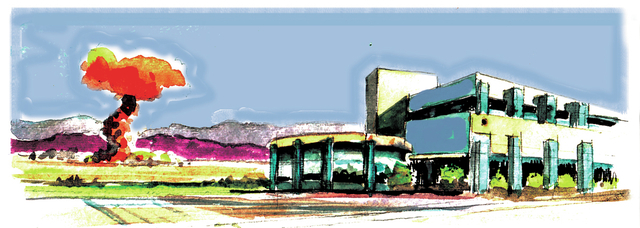Atomic Testing Museum chronicles blasts from the past
Longtime Las Vegans probably recall predawn trips to park along the Tonopah Highway north of town for a really big free show — an atomic bomb going off in the desert on the Nevada Test Site.
Better than Fourth of July fireworks at Cashman Field, the blast lit up the entire sky and was followed by a rumble and vibration. The eerily beautiful mushroom-shaped cloud teemed and churned, hanging high above the desert.
Most residents enjoyed the show a few times, then decided that when you’ve seen one atomic blast, you’ve seen them all. If you lived in Las Vegas in the early 1950s, you experienced that light show and ground shaking at least 100 times. In the late 1950s, an atmospheric testing ban prohibited above-ground detonations. Of the more than 900 atomic tests that took place at the Nevada site, more than 800 were set off underground. Although the specifics of the tests were secret, they were often announced in advance.
Thousands of residents worked at the test site or for associated contractors with business offices in town. What went on at the Nevada Test Site was vital to Las Vegas, playing an enormous role in the development and growth of the city.
Today, visitors to the National Atomic Testing Museum in Las Vegas learn about the dawn of the atomic age, the changes it brought to our culture and our lives and the development of not only weapons, but also atomic energy for other purposes. The museum houses more than 12,000 artifacts from decades of nuclear testing, including some considered top secret until recently. Both static and interactive displays are professional and absorbing, engaging even the most technologically savvy.
Nevada’s only national museum, the facility is located on the campus of the Desert Research Institute at 755 E. Flamingo Road, between Paradise Road and Swenson Street. One of just 37 museums with congressional authorization, the Atomic Testing Museum is an affiliate of the Smithsonian Institution. It continues to evolve and add to its collections since its opening in 2005. The museum invites donations of personal artifacts and first-person accounts from many people associated with the test site over the years.
The Atomic Testing Museum is open daily except for Thanksgiving, Christmas and New Year’s Day. Hours are 10 a.m. to 5 p.m. Mondays through Saturdays and noon to 5 p.m. on Sundays. The facility includes a gift shop and a large reading room adjacent to the spacious lobby. The museum also has meeting rooms and assembly areas for public and private gatherings.
In addition to its main exhibits, the museum features temporary exhibits such as current displays on Area 51, the mysterious, super-secret part of the test site that gives rise to speculation and theories on the possible existence of UFOs and alien visitors. It appeals most to visitors who embrace such science fiction. This popular sideshow opened last year. It will be closed Feb. 25 and 26 for updating of exhibits.
Touring the Area 51 exhibit costs $6 in addition to the regular museum admission fee. Museum admission costs $12 for Nevada residents ages 18 to 61. Nonresidents pay $14. Admission for seniors, active military, students and youth ages 7 to 17 costs $12. Children younger than 7 enter free of charge. Visitors younger than 17 must be accompanied by an adult. Private tours are available on weekdays with prior arrangements for an additional $10 charge. Group tours may also be arranged. For more information, visit nationalatomictestingmuseum.org online or call 702-794-5124.
Visitors with smartphones or iPods can download a free mp3 audio guide from the website before visiting the museum. It provides in-depth information about the tour through the main museum galleries and plays vintage public service announcements from the Cold War era. Bring your own headphones.
Margo Bartlett Pesek’s Trip of the Week column appears on Sundays.






















